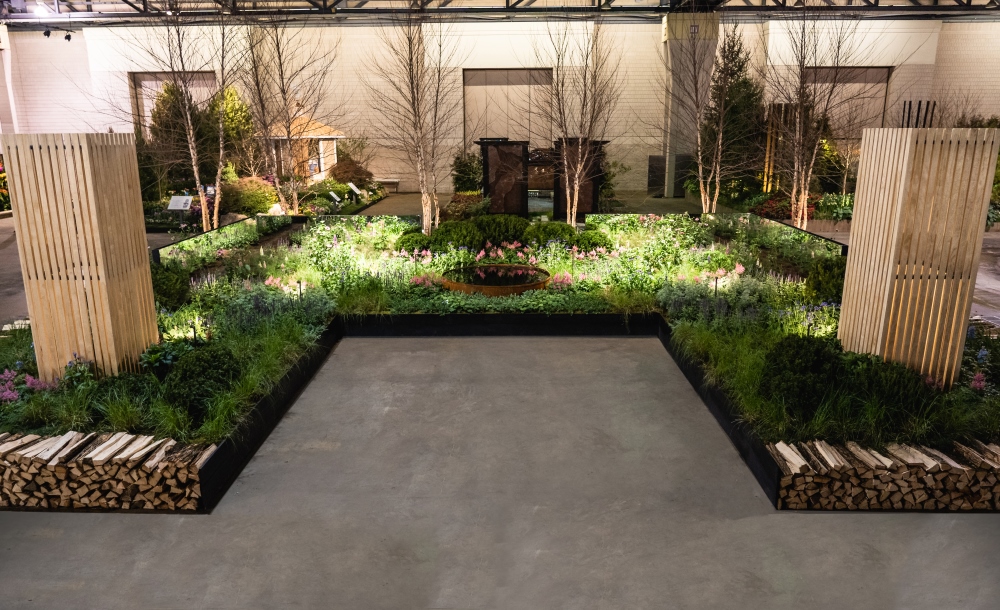
ALL ALONG THE WATCHTOWER. The name of the garden comes from Jimi Hendrix’s performance of the song All Along the Watchtower, which he actually did not preform at Woodstock. My alternative name was Purple Haze, which was a song Jimi did perform at Woodstock. However, since there was concern if we would have enough purple perennials forced to enforce the name, I decided to stay with the one tying the structure to the garden. The initial design featured a key-hole entrance that would allow visitors to enter the garden through a narrower opening and then open up to view the stadium view of the perennial plantings. The plants are mirrored on the left and right by a central axis down through the water feature. I wanted to create a garden that was planted and designed as a real space. The perennials forced in bloom would all align to the same end of May to early June time period. If you pulled out the mirrors this garden would stand on its own planted outside and would not feel forced or themed.
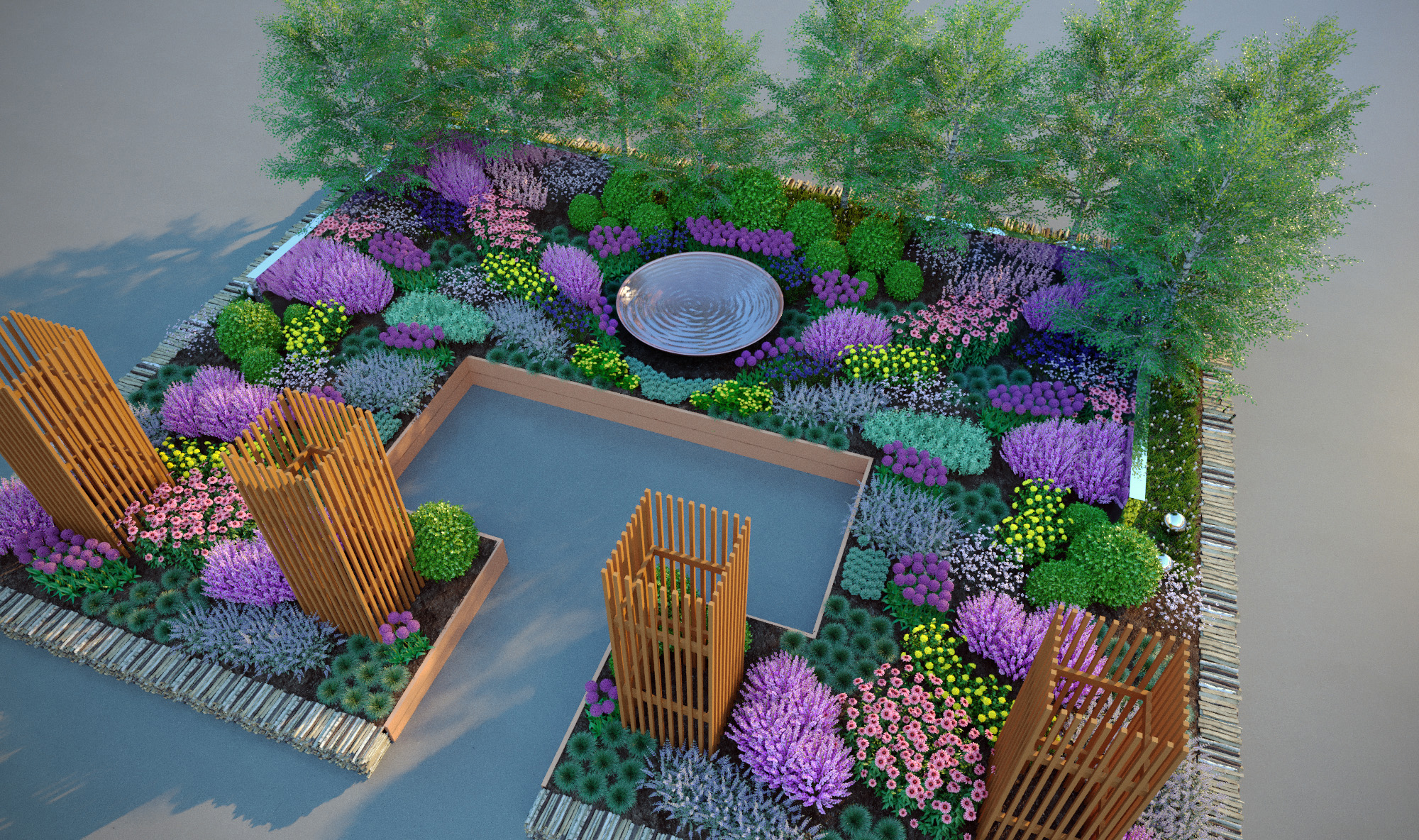
THE PLANTS:
There is a lot of risk in creating a March show garden where your key feature are perennials that typically bloom in May/June. However, I wanted to push the garden design with showcasing more unique plants outside of the easier to force tulips and daffodils. I took a huge gamble on the plants we ended up forcing, and some paid off and some did not. So many of the gardens you see in a show garden like this are so fanciful. Forced out of sequence- lavender and forsythia blooming together in one space… pretty-ish but so unrealistic. I wanted to create a garden that was an accurate representation of a real world garden blooming in a real sequence. To put things in perspective of what it take to achieve this. The perennials had to go through a period of vernalization to bloom. Essentially this is a two month period in which winter is simulated. To achieve this perennials are placed into coolers from roughly October through December. If you were to just plant up the perennials and put directly into a heated greenhouse you would achieve foliage, but no flower. Around Christmas the perennials are put into heated greenhouse with artificial light to simulate spring- early summer. In some cases carbon dioxide is injected to trick the plants even further. If a plant is “finishing” or showing bloom too early they are slowed down by going back in the cooler to achieve bloom for the show and not earlier. We had major winners and a number of complete misses. One thing you will notice as well is we did not force our birch trees. Discussed later in the post.
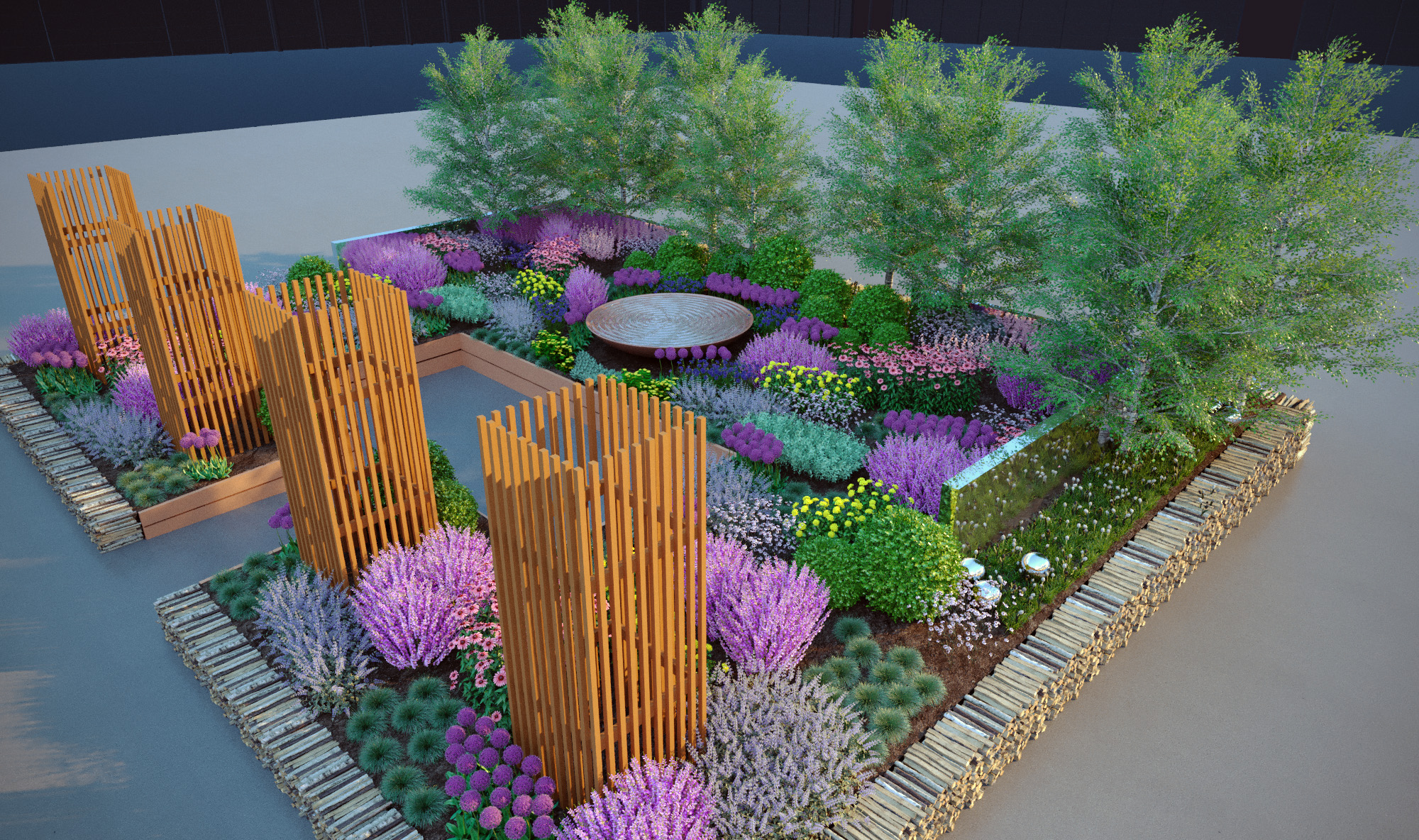
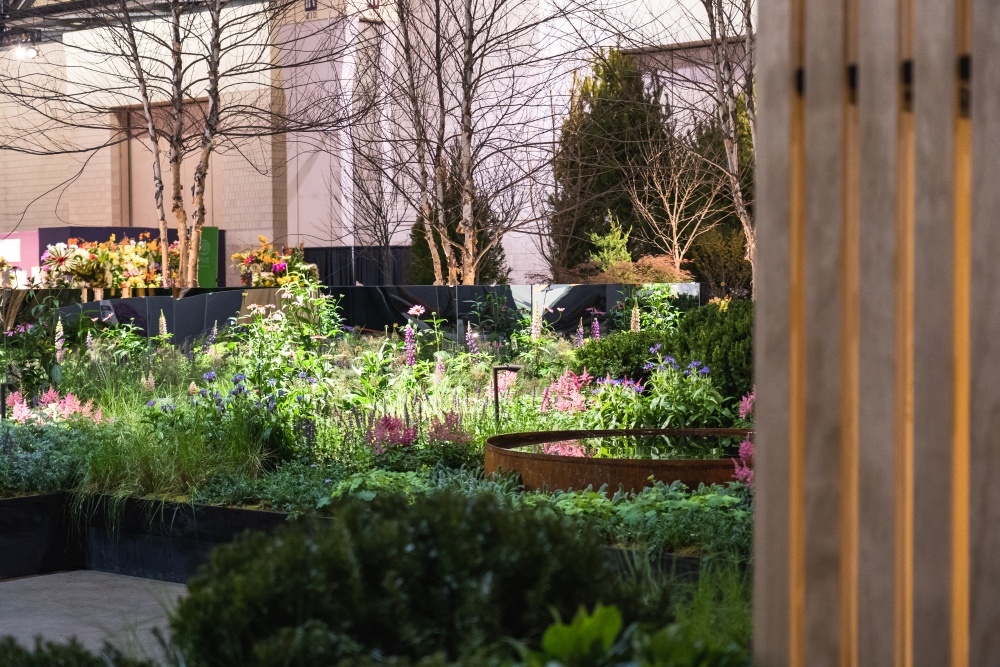
The MIRRORS and WOOD WALLS. Outside of the plants selected for the garden, the use of the mirrors and how they would altered the boundaries of the garden and provided reflection back to the viewer were the linchpin of the design. I did not want the garden to be the mirrors, but the method for communicating endless boundary. Once I created the design, we created mock ups to see how the mirrors would on full scale. First was a small paper model and the second was using mirrors in our home garden. While the paper model was artful, moving the mirrors around my garden at home and understanding plant distance from the mirror and heights of the mirror was a great tool for designing the final mirrored walls.
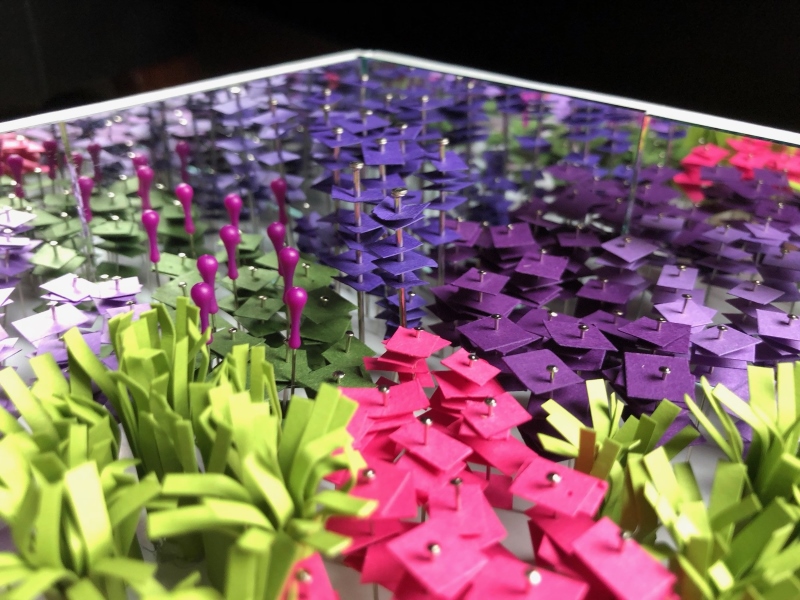
By the mirrors meeting at a 90 degree angle, the plants near the angle would be a multiply of three, the original and then the two reflections. The final mirrored walls were built to be 5 feet off the show floor, with the soil / planting line starting at three feet. This made the top foot of the mirrors around eye level, and the plants mainly just below the 4 and half foot mark. Due to the stretching out of the plants over the course of the show, they started to grow about the tops of the mirrors. Which looked really cool.


The structure supporting the mirrors was created using pallets. I intended to use standard pallets we had at the shop to reuse an existing item, but due to the difference in sizing they would not work to create a level and squared wall. Instead we had specific sized pallets created to the dimensions of a standard mirror we purchased from Home Depot. This helped with the structure and ease of quick assembly during the show. Each of the pallets were torched with a flame to char the wood. This was in the Japanese method of Shou Sugi Ban for creating waterproof wood siding. Since the pallets are made of oak and not cedar, we aided the appearance using a black wood stain. The dark color of the walls allowed them to receded structurally and allow the plant material to be the key visual element.

THE WATER FEATURE. Having a water element to the garden was important for a few reasons. Starting with the design, it provides the grounding central axis line the garden is designed from. all the elements left and right of the trough are mirrored for balance. The circle design provides a contrast to all the squares in the towers, key hole cut out and the over all shape of the garden. Still water is a common element in gardens to create a mirrored reflection, such as at Chatsworth House or Jardins de Quatre-Vents. I wanted to include both the classic use of reflection in water with the forced from the mirrors. Another reason is the importance of water for pollinators and ensuring a garden is a habitat for wildlife. The water feature provides nourishment for bees, butterflies and small animals that make home in our gardens.
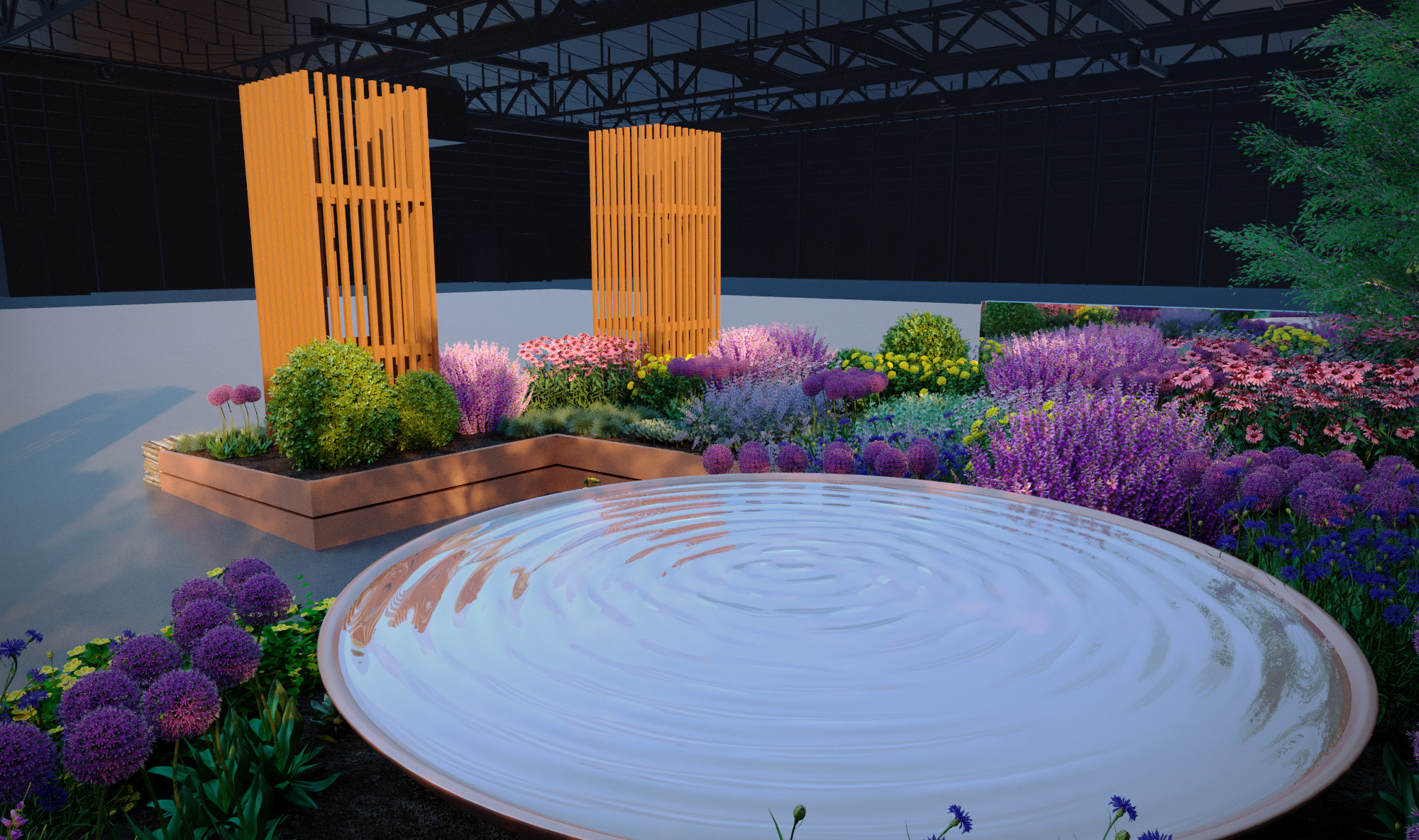
The scaled model also showcased the use of the refection pool and the plants near the edge. When you compare the scaled model to the show garden below you can see how well the model communicated the final effect.
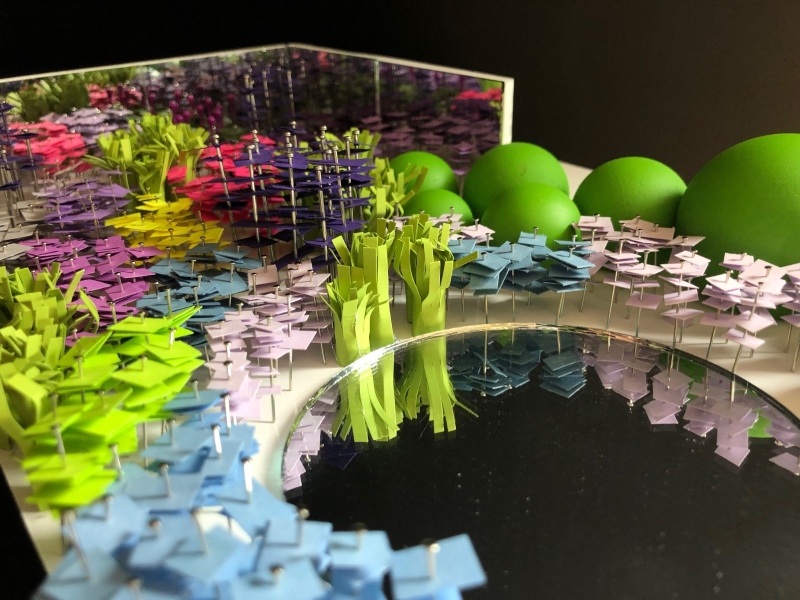
The trough is made from a treated metal to mimic the rusted finish of Corten. We intended to build the fountain out of corten, but since I was not sure if I could get the fountain back to Ohio we decided to get the look instead. The size of the fountain is 7 feet in diameter and 12 inches deep. The size was based on being the largest size I could get on a trailer to ship out to Philadelphia. After the show I am bringing the fountain home to use in my garden. I am also going to fabricate a few Corten troughs and will be available for order. The water is dyed black to provide that reflective quality.

THE TOWERS. The garden is balanced and the tall towers at the entrance of the garden balance the birch trees in the back in height and repetition. The towers are also where a reference to images of Woodstock and the lighting and sound towers flanking the stage. It was these towers where the name of the garden, All Along the Watchtower derived. The towers are ten feet tall and 4 feet square, with a spotlight in the base to light the structure of the tower. We built these in Ohio out of pine, but if used in an actual garden I would use a cedar instead.
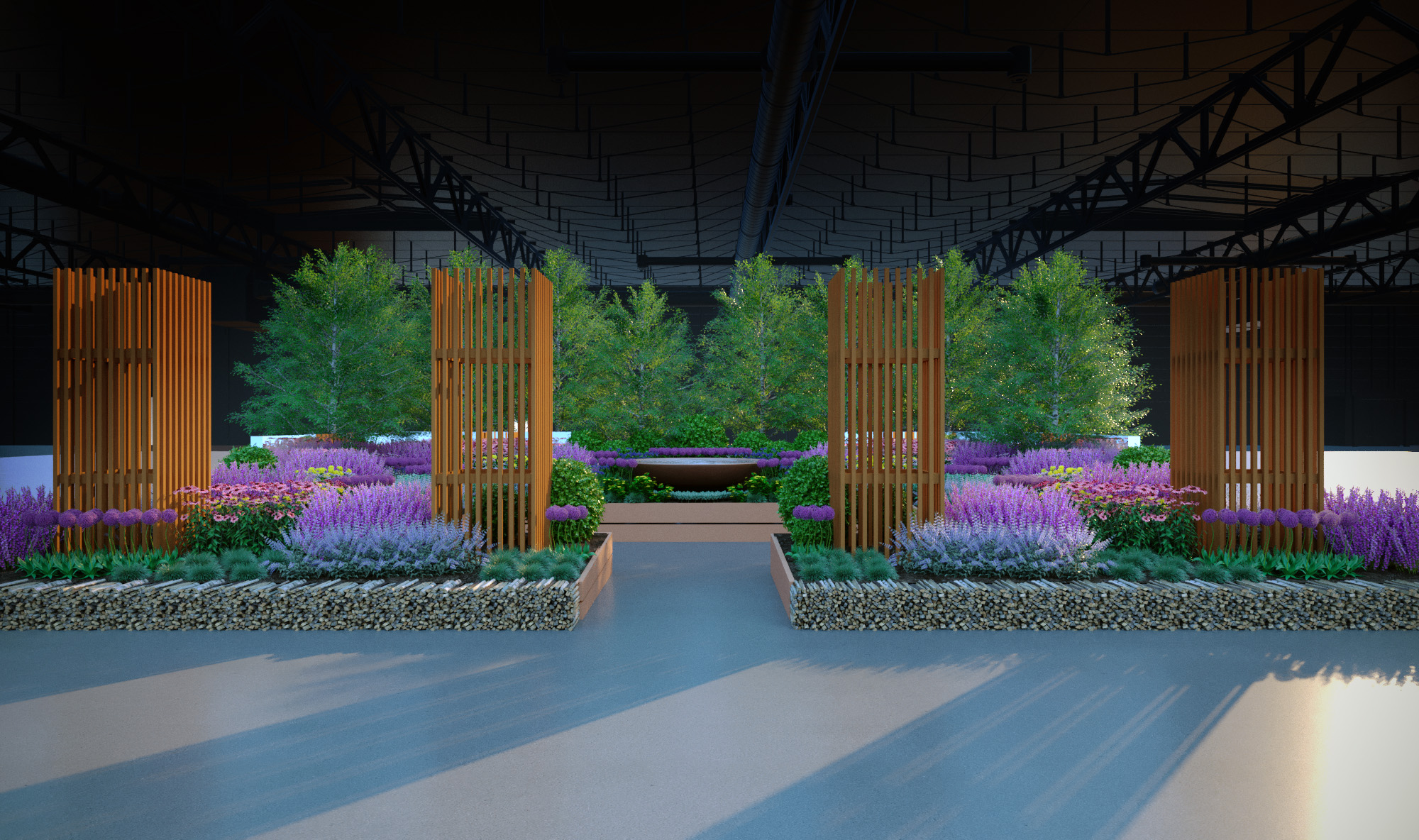
In our shop the towers seemed much taller than when the got inside the convention center. We raised the base of the towers with cinder blocks to get at least nine and half feet above soil level. We also placed mirrors in the top of the towers to compact the light from within. Truly, they didn’t turn out to be as impactful as I was hoping.

THE TREES, WOOD WALLS AND CALM. The edging of the garden was created to be the foil to the riot of colors and patterns inside the garden. This calm moment also references back to the cow pasture field before and after the concert, returning the the bucolic landscape. While the perennials inside the garden bloom end of May beginning of June, the plants on the exterior are spring blooming bulbs. It was important to separate these two seasons of bloom, but still showcase how they can live together in the same space. Since the garden raises 2 feet from the front to the back, this allowed for these delicate spring looms to be raised closer to eye level and be appreciated more intimately. This back section is the only area where my original plant selection from concept to exaction stayed the same.
The mirrors of the interior are referenced using mirrored garden gazing balls. This is another reference to Yayoi Kusama’s Narcissus Garden. I loved the parallel of the traditional garden element, a stainless garden ball, used in her artwork for the late sixties being contemporary today.
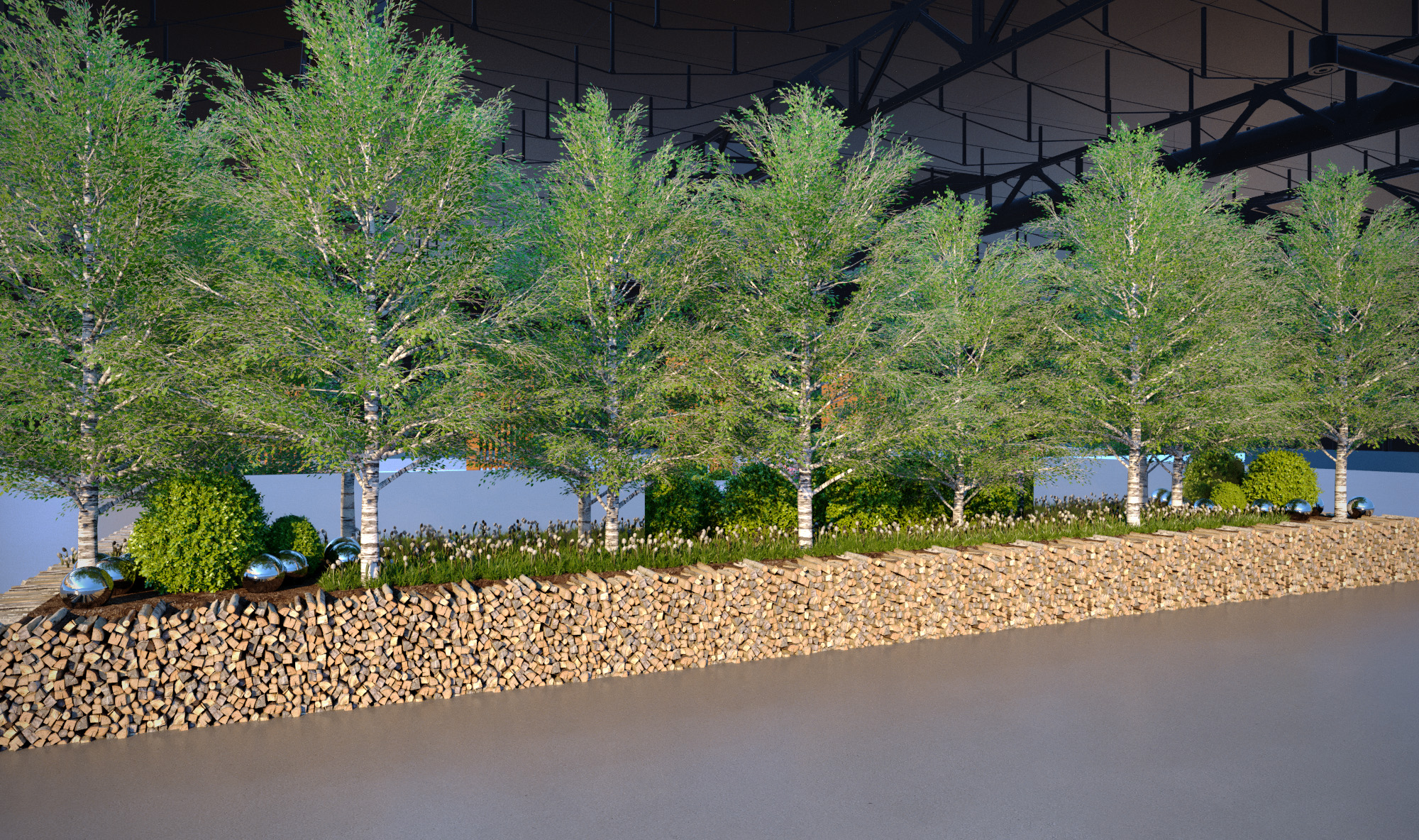
The wood walls framing the garden element came from my garden at home. We lost dozens of Ash trees to Emerald Ash Bore and as results had a lot of wood that needed a home. Instead of moving the logs from the property, I spend my winters chopping firewood and stack wood walls that eventually will run along the perimeter of our property. These walls provide a great sound barrier for us and a habitat and food source for reptiles and insects. On top of the environmental reasons, they provide a structural element to the garden, more artful than a fence.
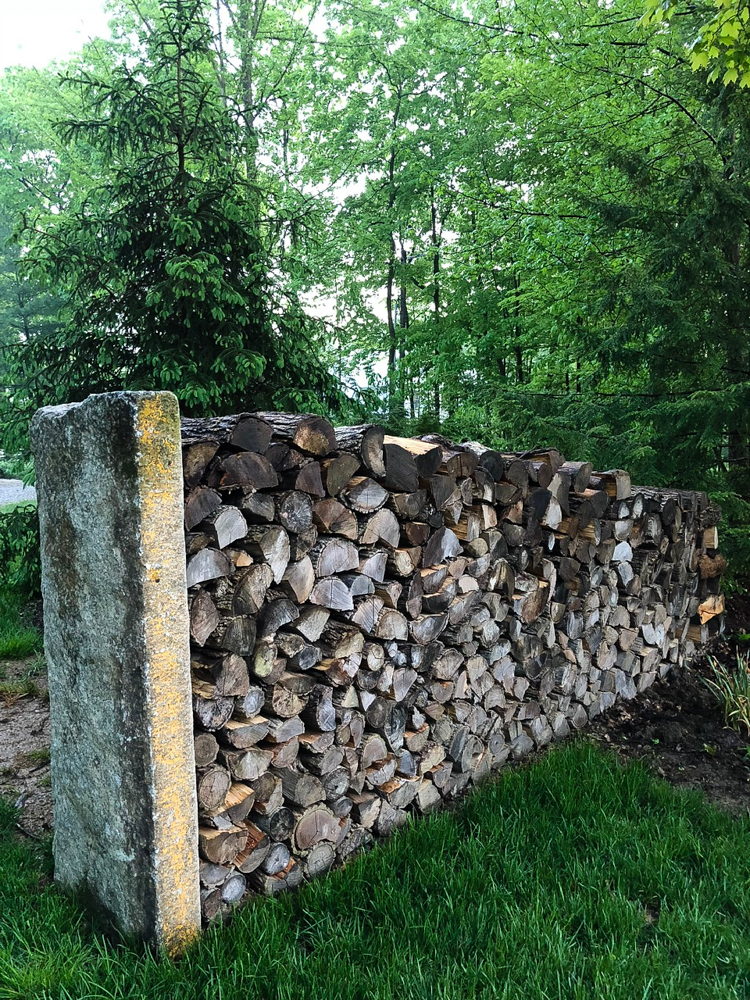
Here is the wood wall at my home that flanks the entrance to our driveway. One end of the wall is supported by a repurposed granite curbing set vertically in the ground. This wall has been standing for two years and has provided a great focal point when entering our driveway and blends well into the woodland surrounding.

The wood walls from the garden were made with unseasoned local firewood, and when you compared to my personal wall look very similar. During the show we included pollinator hotels within the walls to aid in the conversation about making a holistic habitat for pollinators. These hotels are created for solitary bees, where all the nooks are locations for them to nest and lay eggs. We placed five hotels throughout the walls and filled with a mix of materials. The materials included pine cones leftover from our holiday decorations, bark that fell off the firewood during the build, cardboard boxes left over from shipping the materials and many other found objects we had available to us.
The planting scheme for the calm area was designed to be more natural and structured, contrasting from the interior garden. The pallets supporting the mirrors and the taxus shielded the two areas from being seen at the same time. The intention was to use long uncut grass to make it feel even more wild and untouched. However there was a slight mix up on the show floor and only a minor difference in the grass height so it was not fully like the intended inspiration garden at Chanticleer. However you adjust and I still think such a beautiful contrasting feeling to the main garden. 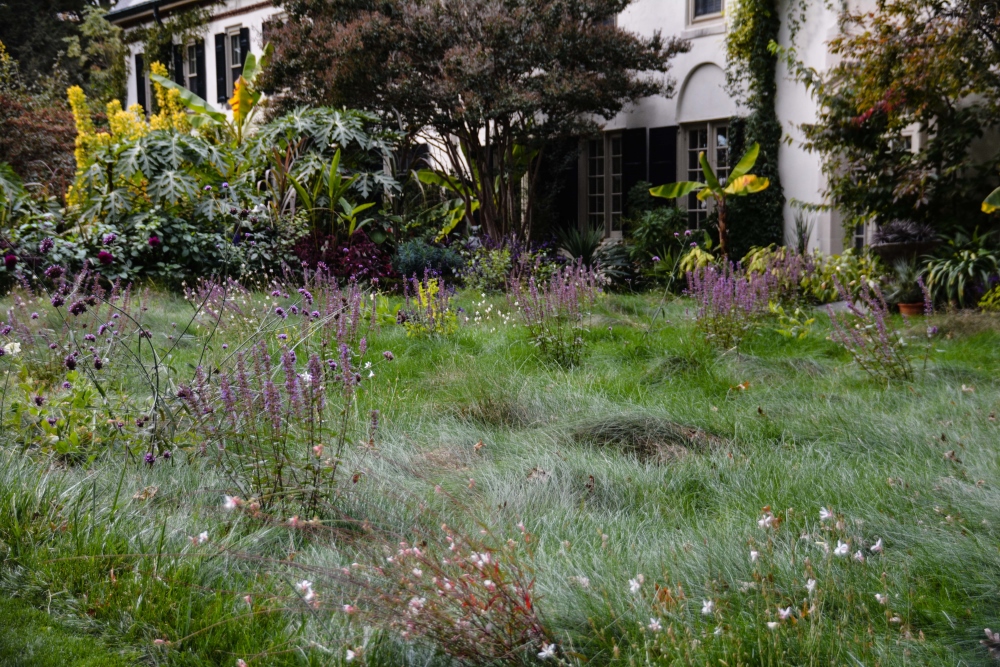
WHAT CHANGED FROM THE INITIAL DESIGN A lot of the other changes came from budget reasons or a plants ability to force out of season. These are all different from the changes that happened on the fly on he show floor during build, but those will be in the next post.
DESIGN. Between my first design and the final design a few items changed. First was the opening of the entrance to the garden. Due to the volume of visitors, the narrowed opening thought as a potential traffic hiccup without allowing two way movement. I decided to open it up to allow for easier access to the garden. This eliminated two of the towers and a grouping of perennials.
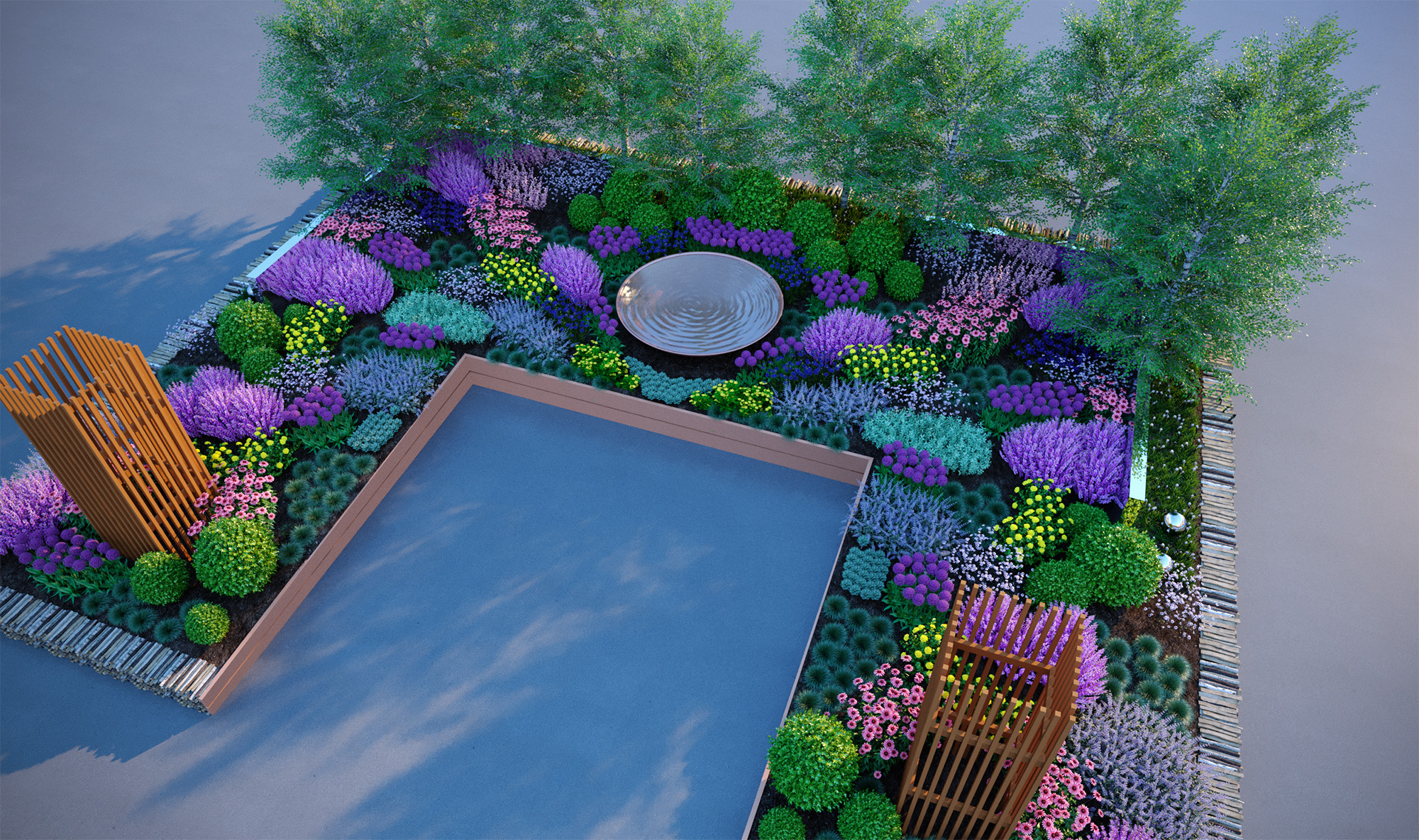
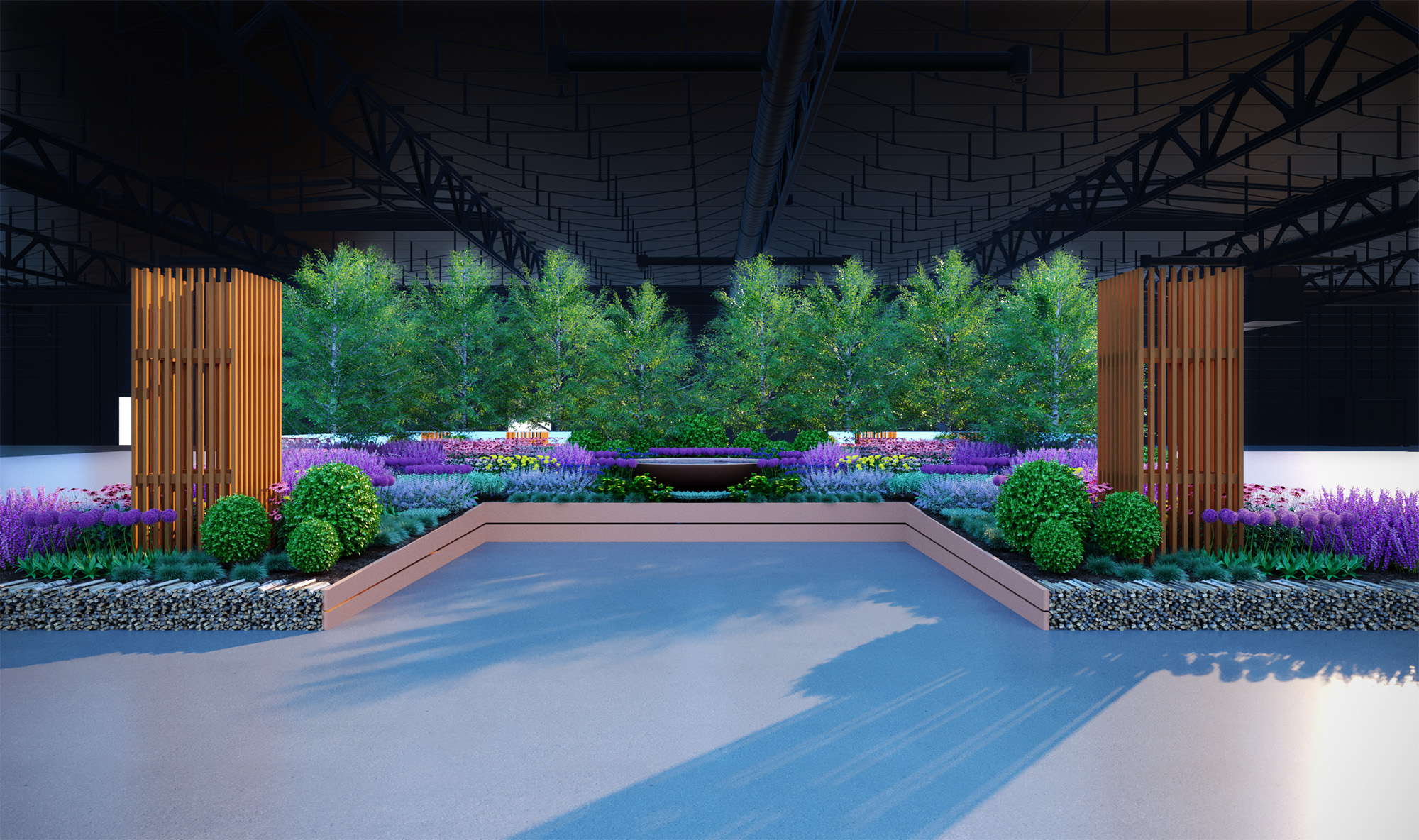
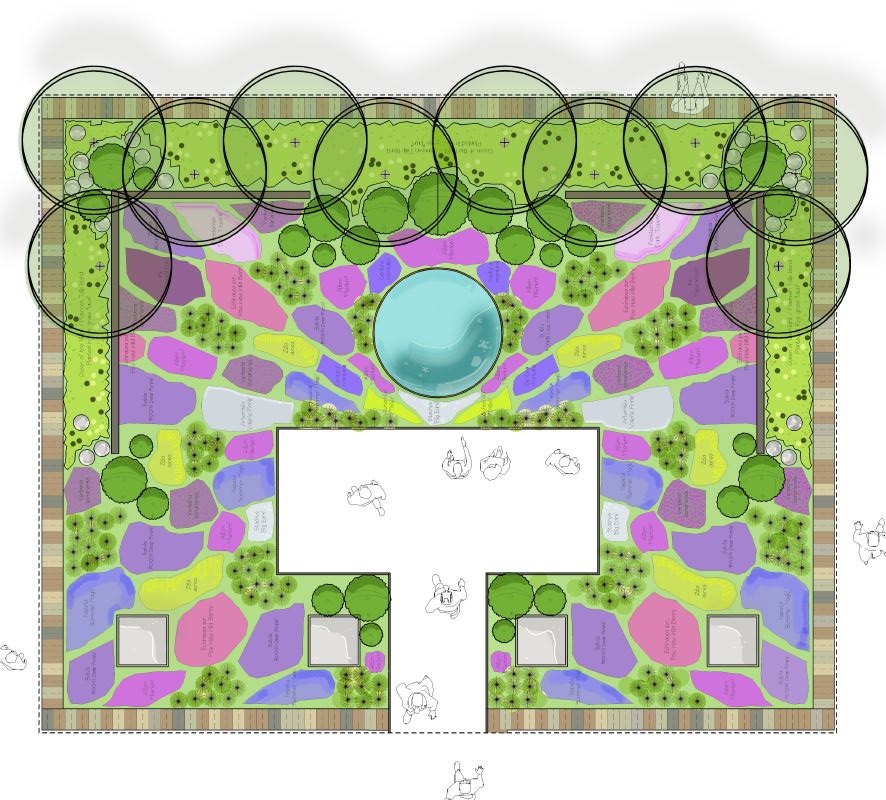
TREES. Next, due to cost and the size of the birch trees (BETULA NIGRA ‘CULLY’ HERITAGE) we selected, the initial count of birches changed from eight to six. This was a minor change and in the final garden I think the original eight at this scale would have been too many and would have crowded the back garden. Also the original plan was to force the trees into leaf, however the cost would have been $10,000. Since I selected the trees for their bark and truck structure, I believed it was better to spend the money on forcing the perennials instead. This was an ecological and economical decision. The amount of energy to force such a large tree is immense! The time required is also very long for birches. As you know time is money. In this case bucket loads of money! The major advantage of not forcing them is that these birches will be able to live on after the show. So many of the trees that you see forced in the show can not survive after the show and are literally chipped up on the loading dock post show. The sad reality.

Here are the trees in the ground back in October as I walked and tagged my selection. You can see how the leaves block the structure of the branches. Also since I had these planted on the back side with the daffodils and muscari, it would not make sense to have these forced into leaf. (NOTE we lost points for these not being forced in judging)
SHRUBS. My original plan called for boxwood to be used for the evergreens, but based on the size and quantity I needed it became cost prohibitive. I swapped out the boxwood for yews (TAXUS X MEDIA ‘DENSIFORMIS’) and was able to source from a grower in Ohio. The central taxus in the garden is almost 5 feet across and still again were able to provide the structure in the garden I was looking for with the cloud pruning. If I was to plant this as a real garden I would go back to the boxwood, most likely a variety like B. ‘Winter Gem’ or B. ‘Green Velvet’
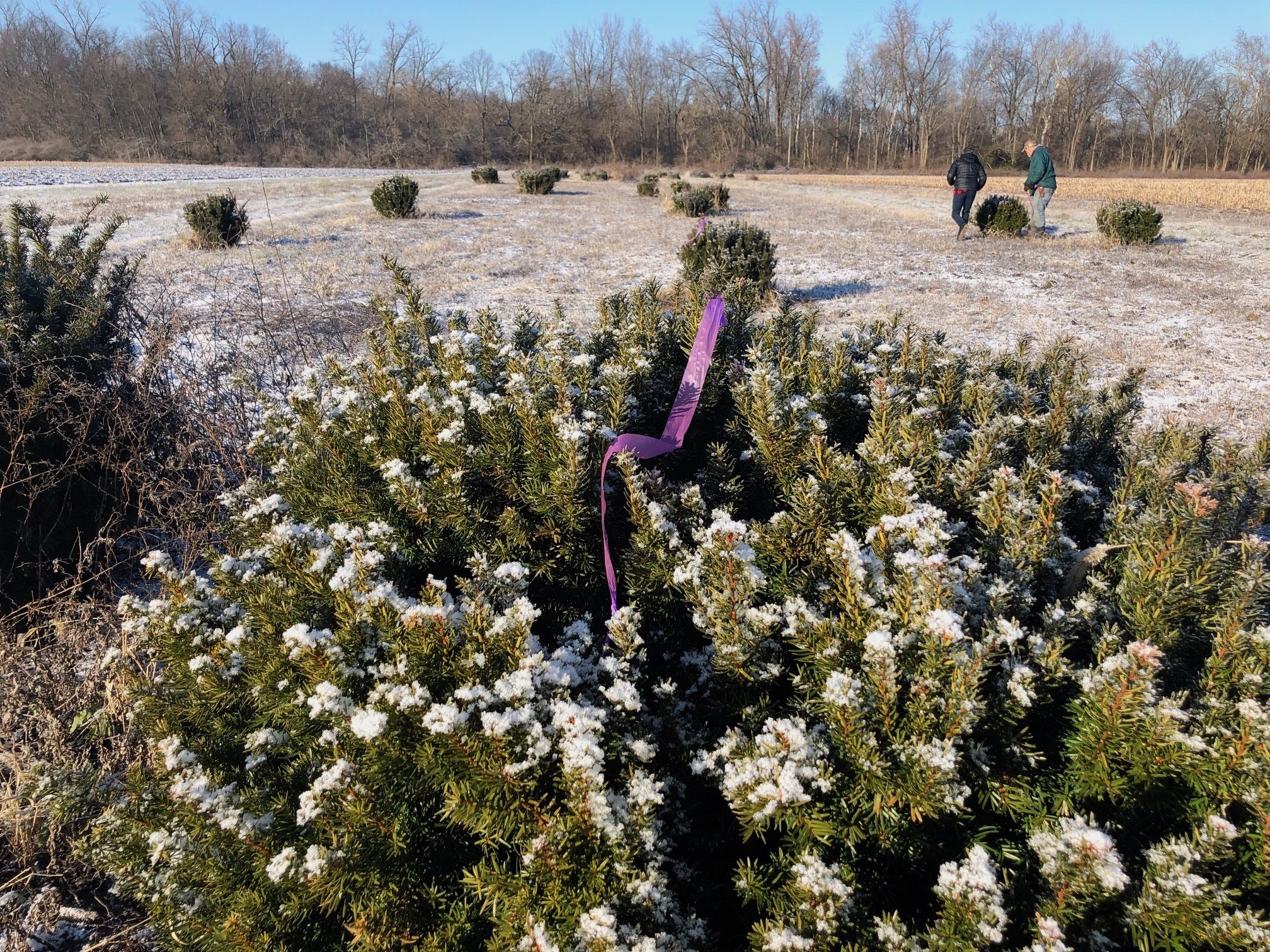
Back in December I selected the taxus from the fields, moved into our greenhouses and shipped out to Philadelphia in January. Since the size of these taxus were so much larger than I anticipated with boxwood, were were able to eliminate a few from the original design. Also once we got to the show floor, we had to eliminate a few more since they did not survive in perfect condition from all the handling.
PERENNIALS. The biggest evolution of the design came from the perennials in my original design to those in the final garden. I started with selecting the perennials I would use if this was going into a client’s garden. Our partner in the garden, Stoney Bank Nurseries, they evaluated the list against their 40 year history of forcing plants for the flower show and what varieties do not have success forcing out of season. This was a long back and forth with the list changing as we went back on forth.
Below is the list of the first plant list that aligns to the first design and then the final plant in the garden. I will update this list over the next few days with links, just want to get this content out quickly. Also, I will create a final graphic with all the plants used in the garden along with the design in the next week.
Original Plants – IN THE FINAL GARDEN
- BETULA NIGRA ‘CULLY’ HERITAGE
- TAXUS X MEDIA ‘DENSIFORMIS’
- ALCHEMILLA MOLLIS
- CENTAUREA MONTANA
- ZIZIA AUREA
Original Plants – NOT IN THE FINAL GARDEN
- Nepeta grandiflora’Summer Magic’
- Salvia ‘BBSAL09001′ – Salvia Rockin’ Deep Purple
- Echinacea purpurea ‘PAS702917’
- Allium ‘Millennium’
- Verbena bonariensis
- Stipa tenuissima Mexican feather grass
- Artemisia ludoviciana ‘Valerie Finnis’
- Stachys byzantina ‘Big Ears’
- Penstemon ‘Dark Towers’
- Iris ‘Superstition’
- Allium sphaerocephalon
- Eremurus × isabellinus ‘Cleopatra’
- Eremurus stenophyllus
- Tulip Black and White Tulip Collection
Substitutions – IN THE FINAL GARDEN
- SAMBUCUS RACEMOSA ‘SMNSRD4’ LEMONY LACE
- ARTEMISIA ‘POWIS CASTLE’
- ASTILBE ‘RHEINLAND’
- CAREX VULPINOIDEA
- ECHINACEA PURPUREA
- IRIS SIBIRICA ‘CAESAR’S BROTHER’
- NEPETA X FAASSENII ‘BLUE WONDER’
- STACHYS BYZANTINA ‘SILVER CARPET’
- FOENICULUM VULGARE ‘PURPUREUM’
- SALVIA NEMOROSA ‘VIOLET RIOT’
- VERBENA ‘RIKAV18302’ VIOLET ICE
- NARCISSUS ‘MOUNT HOOD’
- NARCISSUS ‘MISTY GLEN’
- MUSCARI AUCHERI ‘WHITE MAGIC’
- MUSCARI ARMENIACUM
- DIGIPLEXIS ‘FLAME’
- LUPINUS POLYPHYLLUS
- LUPINUS MINARETTE GROUP
- DELPHINIUM ‘MAGIC FOUNTAINS SKY BLUE’
- SCABIOSA ‘BUTTERFLY BLUE’
WHAT DID NOT CHANGE. Overall not much of the overall concept changed from October to the installation, however once we got on the floor we shifted planting forwards or backwards to best play with the mirrors. However the bones, structure and purpose of the design stayed as designed.
PLANTING PLAN. If you look at the planting plan, the layout of all the plants in the stadium area is the same. I only changed what plants went into those spots based on how they looked on Wednesday morning. Given the fact we built the structures in Ohio and did not get to see all the plants together until Wednesday morning, I think the process of execution went very well. That is not to say there was a lot of thinking on the floor and things that did not work as expected due to forcing issues.
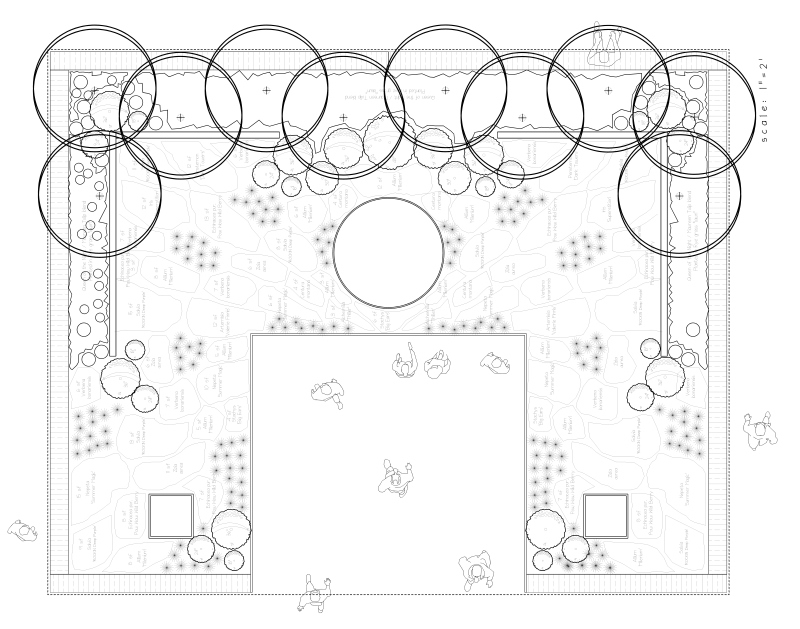
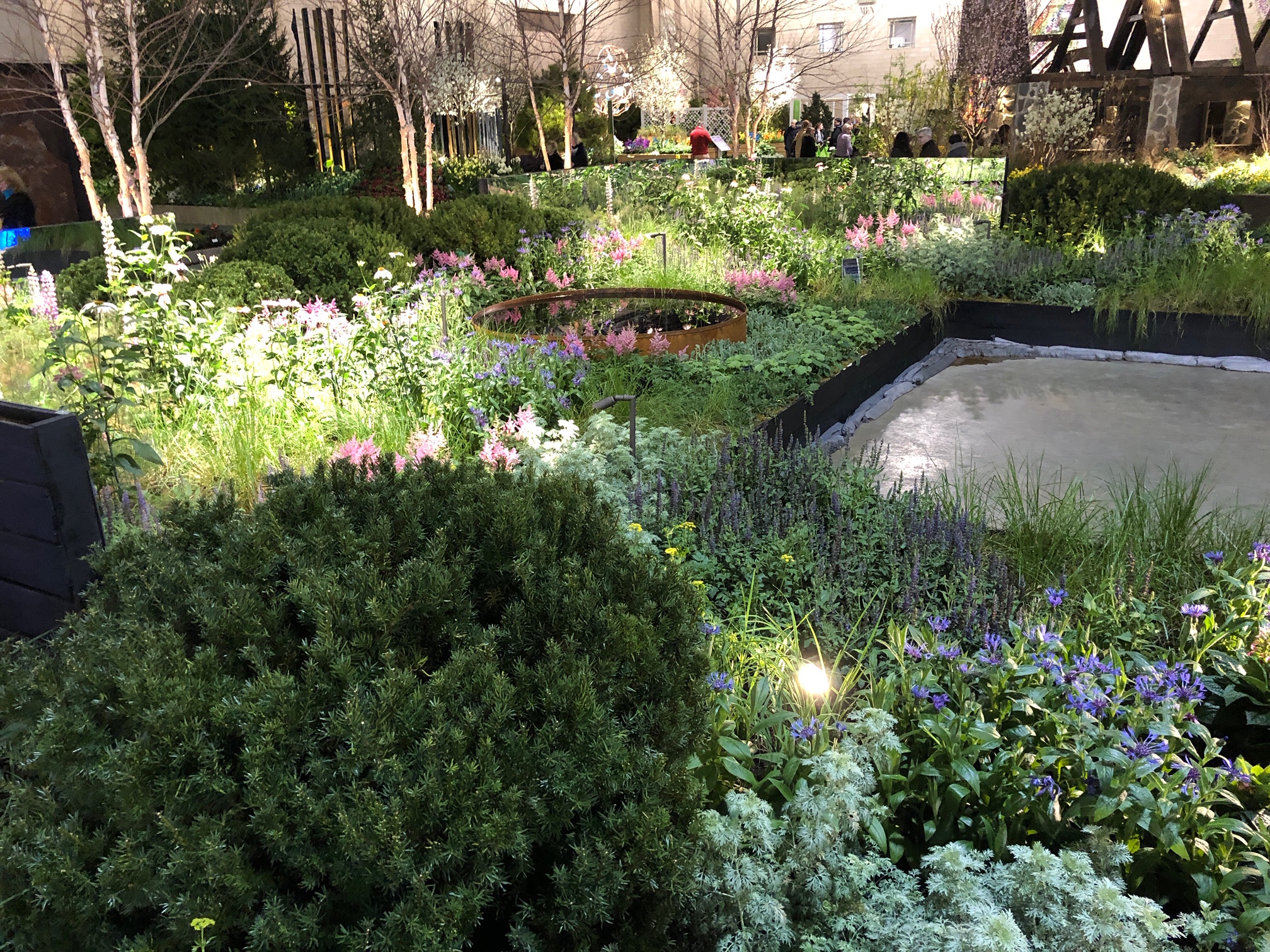
LIGHTING. The lighting plan from design to the show garden did not change very much. Again, like the planting plan this was all worked out with a reasoning behind the fixtures selected. I had left the path lights used to highlight key blooms flexible for what was looking best in the garden, but the spot lighting, and use of path lights did not change from the first plan. We ended up not not using all the lights flushing the black wall, the spacing back there was tighter than originally drawn due to reducing the garden by a foot to allow tighter access into the garden.

This is the lighting plan we created when running the specific wiring structure we could use during the show. Since were were limited on the wiring we could do inside the convention center, all the hooks ups and connections were pre-made with specific junctions.

Here is an example of a Hinkley Lighting Hardy Island Spot light with stem used to highlight the blue flowers of Centaurea Montana. Typically I use this slim profiled light on path ways since they receded into the garden, but still provide ease with directing light where you needed down a path or on a key feature. I think this is also great for a garden that the peak bloom changes through the season, these lights allow you to adjust as the blooms change.
More to come. Check back.

Hi Nick,
This was such a great recap!! I was so interested to learn about the forcing process when I was at the show and saw all your perennials in bloom. You have such a thoughtful and detailed design process which really came across in the final project.
Congrats!
Justin
Justin,
Thank you so much! I am so sorry I didn’t get to catch up with you while you were there. The devil is in the details! I wanted to make sure I showed the ins and outs of the process- that is truly the interesting story. The garden is great, however, the process is creating that garden is so much more involved than creating a garden in its “normal setting”.
Thank you so much!
Nick
Nick,
I have attended (and participated) in the PHS Flower Show for a number of years. However this is the first time I had the opportunity to see the plans and planning that actually go into designing and installing a garden display at the show. Your display was my favorite, it looked like a garden. In my opinion, too many displays try too hard to be unusual and end up looking artificial. Thank you for sharing.
John Drexel
LandArt Garden Studio, llc
John,
Thank you so much for your generous comment. My goal truly was to create and garden, not a show….. something that was accurate and attainable. The show was an absolute roller coaster and I loved the challenge of the design and installation. In the end we were so happy with the results. Thank you so much for following us on our journey- more to come!
Nick
We attended the PHS show and I was absolutely enthralled by your exhibit. It was a refreshing change .. and my favorite .. the simplicity of the wood wall surrounding the exhibit, the reflecting mirrors, the stunningly simple water feature .. not to mention the gentle sweep of colors … all so doable .. and THANK YOU for your generosity of sharing Behind the show garden.. I wish I loved closer to Ohio !
Magnificent …
Susan Mattioni
Susan,
Thank you so much for your kind comments! It was certainly a labor of love and in the end the garden was portrayed exactly how I was hoping. My goal going in was to share all the information about the garden, the plants, the components, etc. Thank you for following the journey and supporting us. Keep following, there is more exciting stuff to come! Thank you again….
Nick